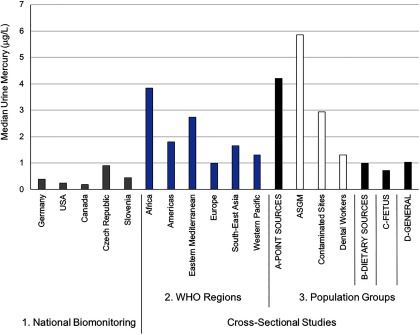Figure 5.
Median urine mercury levels across different population groups. The National Biomonitoring Studies (#1) provide country representative information on exposures. For the Cross-Sectional Studies, all data are organized according to WHO geographic region (#2) and Populations Groups (#3) that were set a priori. Under the four main Population Groups categories, the first bar (black shade) represents the pooled biomarker data from the respective subgroups that follow (indicated in white shade and labels prefaced with letters A–D). Subgroups that fall under the Point Sources group (A) include ASGM (individuals engaged in artisanal and small-scale gold mining); Contaminated Sites (individuals living at contaminated sites); and Dental Workers (individuals exposed from working in dental settings). The Dietary Sources group (B) includes populations who consume relatively high amounts of seafood. The Fetus group (C) includes populations who are vulnerable because of early life exposures. The General group (D) refers to the background population without specific exposures to mercury. Note: WHO, World Health Organization. For source data, see Table S7.

